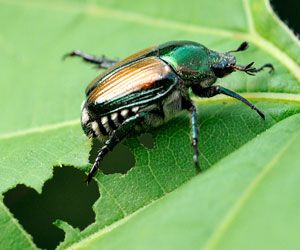How To Get Rid of Japanese Beetles From Your Plants

Japanese beetles are common voracious pests that eat up to 400 different types of plants. Over the years, beetles have become serious pests in orchards, lawns and gardens. This is because, once they find a sufficient food source, they secrete a pheromone to attract more beetles. This means, in a short while, they can easily destroy your plants, flowers and trees. If your plants are facing threat from these tiny weapons of mass destruction, then you need some effective methods to eliminate them. Here are tips on how to rid your plants of Japanese beetles.
1. Picking the beetles
If the plants are not heavily infested, the insects can be picked off the plants. The beetles are then drowned in soapy water before their population becomes too dense. The best time to hand pick the pests from the plants is in the morning or late evening, when the adult beetles are sluggish and not active. The soapy water kills and prevents the adult beetles from producing the pheromone that attracts other adults to the feeding site.
2. Pesticides
Eliminating Japanese beetle larva, or grubs, saves your plants and prevents them from developing into adults. The C-shaped, creamy white, dark-headed larvae are prey to rodents, raccoons and skunks. Digging by animals together with dry, brown plants indicates a grub problem. The grubs can easily be controlled with insecticides. The pesticides have bacterial that is ingested by the grubs. The bacteria will then multiply in the grubs till they all die.
Insecticides can also be used to kill adult beetles. The insecticide can be highly toxic to aquatic organisms, non-targeted insects, pests and children. The insecticides should not come into contact with eyes, skin and clothes. For this reason, this job needs to be handled by a professional as he/she will help in deciding what the right pesticide for your plants is.
3.Traps
Traps can also be used to control these pests. There are two types of traps, one that uses female beetle pheromones and another that uses the smell of its favorite food. One of the most effective baits for these beetles is a banana. The insects cannot resist the sweet taste of banana. Placing the traps around your garden creates a pleasing odor for the beetles. The insects will then crawl into the trap, but will not be able to find their way out, as Japanese beetles are terrible fliers. The trapped beetles are then killed by dropping them in soapy or salty water. You may need the help of a professional pest controller as these traps may attract more beetles than you can trap.
4.Repellant plants
Just like many insects, adult Japanese beetles can be controlled by using repellant plants. Examples of plants that repel the beetles include chives, catnip, tansy and rue. The problem with planting some of these plants, like catnip, is that some are actually weeds. The weeds are not healthy for your plants, as they will just suck up water and nourishment from your plants. The best way is to spread the leaves of cloves, catnip or garlic around the garden. Spraying a mixture of water and rue on the plants can also help keep the beetles from your garden.
5.Exclusion
Exclusion involves covering plants with cheesecloth or a similar mesh material. The mesh doesn’t need to cover the plants for a whole season, just during peak Japanese beetle season, which lasts for a few weeks. Beetles tend to consume plants from the top downwards towards the roots. Thus, the mesh placed on top of the plant will deter them from attacking your plants and the pests will therefore move to other food sources. A professional will choose the perfect mesh cloth (no larger than ¼ inch), as anything bigger will allow the beetles to go through the mesh or eat the plants between the mesh.